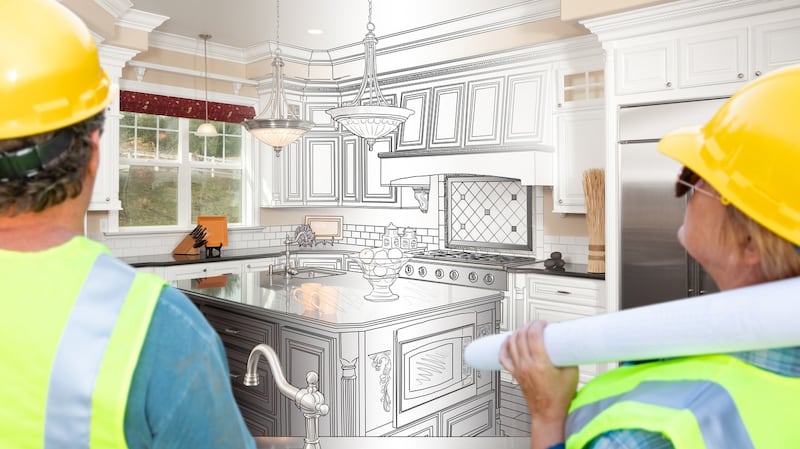If you were thinking of refurbishing your home, spending so much time there right now is probably amplifying any niggles. With kitchens across the country strewn with dishes, laptops and jigsaws, a better layout may appeal. While renovation works may not be an immediate priority, knowing the costs will help when the time is right.
Let’s take a typical three-bed semi – how much you have to spend may be a more realistic starting point than your wish list, says Noel Larkin. As chairman of the building surveyor professional group of the Society of Chartered Surveyors Ireland, and with his own practice in Dunshaughlin, he helps clients to balance design and cost.
“How much is it going to cost is the first question everyone asks,” he says. “In reality, my first question is how much have you got to spend. You try to tailor the job backwards from there and say you can afford this, or you can afford that.”
They are seeing these lovely open-plan houses with big glass walls and saying, well, I want that too
Sunday night used to be about watching Glenroe, but in latter years it has become home improvement shows. People want what they see, says Larkin. “They are looking for that open-plan living space where the kitchen, dining and family room are all in one. They are seeing these lovely open-plan houses with big glass walls and saying, well, I want that too.”
Opening the back walls to let light in and removing the wall between the dining and living rooms to make an L-shaped space, perhaps with a stove, is a common request. A better kitchen is always on the wish list, with an island, or a peninsula if there is less space.
“You can easily get rid of €40,000-€50,000 in a refurb like that,” he says. “You could spend €20,000 on a kitchen or you could tailor that back and get a kitchen in some of these DIY places for €5,000. It depends on how much you have to spend.”
But don’t set your heart on that flash kitchen before covering the basics. Knocking walls has a knock-on effect, like switching electrics and radiators, which adds to cost. Fitting an engineered steel beam where a load-bearing wall is removed is expensive too.
“That can be €5,000 at a very bare minimum – that’s getting someone to design it, sign-off on it and give you a cert,” says Larkin.
Floors can be another unexpected cost. “When you knock through a wall, there could be a half an inch of a difference in floor level, so there are many hidden things that can come up.”
In Cork, the “as seen on TV” factor is also alive and well, says Douglas-based quantity surveyor Karl Slyne. He sees most three-bed semi-detached homeowners opting for a single-height extension to create an open-plan living space. Changing layout within the existing footprint is often too restrictive, he says. By keeping the extension to 40sq m, planning permission is not required, speeding things up.
For a “full package” – including the kitchen, painting, tiling and finishes, homeowners should budget for €1,800 per sq m (ex VAT) “for a really basic” scheme, says Slyne. A pricey kitchen, nice roof lights, lots of glass and a wide sliding door at the back will see costs climb to €2,500 per sq m, or about €100,000. Adding under-floor heating to a small extension will add about €8,000.

He advises homeowners to make an architect their first port of call. A quantity surveyor will then check costs based on the drawings. “You don’t want a design for something you can’t afford, and that does happen.”
He estimates architects in Cork may charge €3,000-€5,000 for a small extension. A quantity surveyor will charge €2,000-€2,500, but he advises hiring one is probably spending money to save money.
Plan ahead too. If you are opening up the back of your house, summer time is better. Move out for at least part of the build if you can. As to the availability of a builder and trades, the Covid-19 pandemic is likely to have an impact, says Slyne. “It’s been a very buoyant market, but this could change drastically, for obvious reasons.”
An architect may have a preferred builder or you can shop around yourself. “Keep it tight. Pick three builders based on recommendations and get prices off them. In Cork, if contractors find out Mrs Murphy is asking every builder to price it, they aren’t interested.”
Where a quantity surveyor is hired to provide a full service, they will oversee costs, says Slyne. “People can be naive about paying contractors upfront. We can put a contract in place with staged payments, so if the contractor comes looking for €30,000, we will check to make sure the work is done. We are basically controlling the costs, giving the client peace of mind that it’s not going to run over.”
Galway-based building surveyor Fergal Bradley agrees with estimates of €1,500-€2,500 per sq m. “It won’t be less than that, but it could be substantially more, depending on your specification,” he says. The cost of adding an extension to a house built in the 1950s and one built in the 1990s can vary widely, however. While extension costs will be the same, the additional work required to link the old to the new could be substantial.
In a 1940s or 1950s house, you may find there are asbestos-containing materials that are expensive to remove, you may have to remove floors to access pipe work and single-glazed windows will have to be replaced. “These are things that can add a significant cost to a project,” says Bradley.
If you do an extension to an older building, the regulations require energy efficiency upgrades to the existing structure
Older builds won’t have cavity block walls and this requires more expensive insulation. Rewiring an older property can cost about €8,000 alone, he says. “After paying to make the property good in the first instance, often there is very little finance left for the extension they had hoped to build.”
Building regulations require extensions to older homes to tackle the energy efficiency of the original structure too. “If you do an extension to an older building, the regulations require energy efficiency upgrades to the existing structure,” says Bradley. “A lot of people aren’t aware of that.” That means money spent on things like wall insulation, attic insulation and a new heating system.
The Royal Institute of the Architects of Ireland estimates the cost for a basic single or two-storey extension to be €1,900-€2,300 per sq m. This assumes traditional materials, standard construction methods and a flat or pitched roof.
Factor in renovations to the existing house and a new kitchen and costs are up about €2,000 or €2,500 per sq m. High-quality finishes can see the cost climb to €2,600 or €3,400. Tricky site access, where manual labour may have to replace the work of a mini-digger, will add costs again.
There are ways for householders to save money too, says Noel Larkin. For example, by removing just the double doors and architraves between linked rooms, rather than the entire wall. “You are getting an open-plan effect without the full cost of removing that wall,” says Larkin. Another tip is to retain the carcass of your kitchen, just change the doors. In an existing single-height kitchen, roof lights can be a cost-effective way of getting light in. Two Velux windows combined with the necessary carpentry and plastering, will cost about €3,000, he says.


















